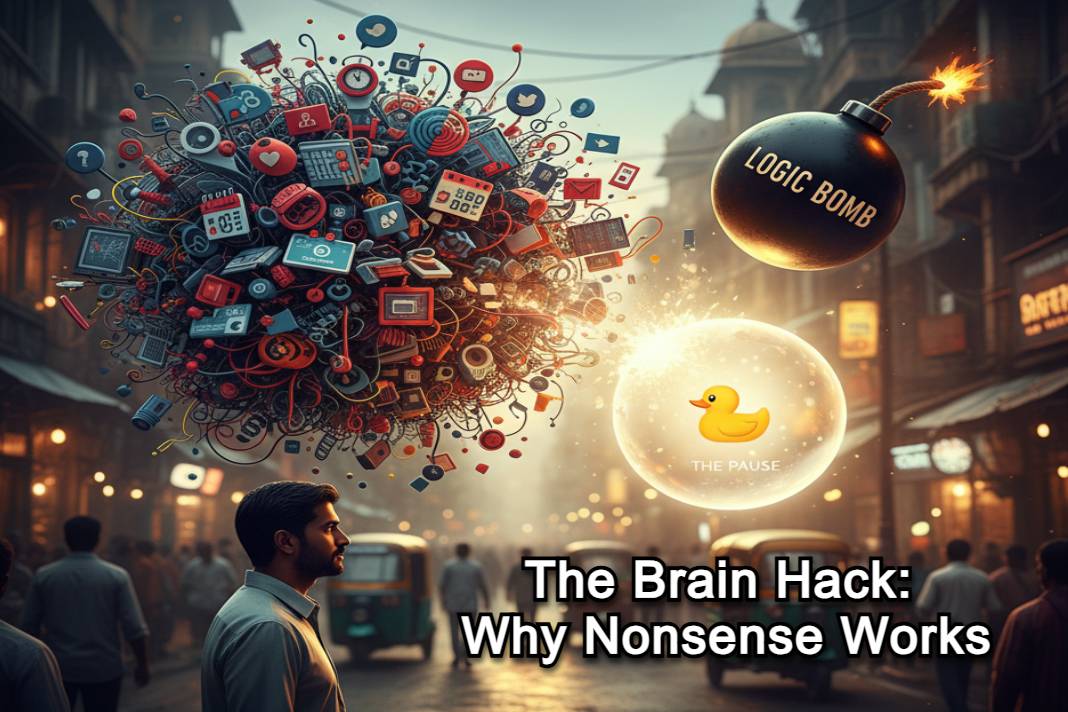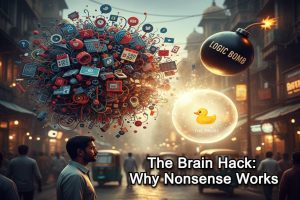A casual chat between two friends, Aman and Riya, navigating college or early career life in an Indian city.
Aman (A): Yo Riya, have you noticed how we’re always just… on? Like, my brain never stops running. I read this thing that perfectly explained it.
Riya (R): Stop running? Bro, my mind is in full-on traffic jam mode 24/7. What did you read? Is it another self-help guru on YouTube?
A: Nah, it’s the core philosophy behind a lot of our older traditions. The idea is that your brain is a Self-Powering Thought Engine. It’s constantly thinking, right? It takes your exam pressure, your parents’ expectations, the last thing your crush texted, and weaves it into one non-stop movie—that’s your “mind.”
R: Oh, the mind! Yeah, that endless stream of thoughts, memories, and future panic… like my personalized, non-stop OTT subscription.
A: Exactly. And the mind is a demanding boss. Once it has the narrative, it craves more fuel. It demands more thinking: recalling old family drama, defending your low marks to your uncle, planning your entire five-year career path. All that overthinking burns insane energy and produces this intense hormonal exhaust—the Rajas/Tamas surge. It’s the feeling of that Sunday night stress headache, or the urge to just crash and binge-watch for ten hours straight.
R: That explains why I feel so thakaan (tired) all the time, even when I’m just sitting and scrolling. So, if I want to escape this, I should do something calming, like yoga, right?
A: See, that’s the trap! It’s the problem of “Sense.” As long as an action “makes sense” to your logical mind, the mind co-opts it.
💡 Real-World Example 1: The “Mindful” Chai Break Fail
A: Let’s take the classic break: You go for a walk to the nukkad (corner) shop for a chai to “clear your head.” That makes sense. But what are you actually doing on that walk?
R: I’m calculating if I should drop out and start a YouTube channel, checking my bank balance, and mentally writing the apology to my professor.
A: Exactly! Your mind tags along. It says, “Superb idea! A chai-break! I will use this time to perfectly strategize my next move, and perhaps worry about the GST on the biscuits!” The sensible break just becomes a new location for the same old thought loop. The mind is a master at turning self-care into more fuel.
R: Okay, so I can’t out-logic the mind. How do I actually stop this loop?
A: You need to hit it with a Logic Bomb. You introduce something that is inherently non-sensical. This is the ancient, clever purpose of a Ritual.
💣 The Ritual as a Cognitive Pause (The Logic Bomb)
A: Think about the rituals we see every day.
- Why does your Dadi (grandmother) have to stand in front of the Mandir (altar) for exactly 10 minutes, ring the bell three times, and then touch the aarti flame in a precise order?
- Why do you have to do the same complex hand gesture (mudra) during a specific puja?
R: Yeah, I always thought it was just… tradition. But none of those steps have a logical, utilitarian purpose. They don’t magically fix my Wi-Fi.
A: Correct. Your hyper-logical brain, the “CEO” (Prefrontal Cortex), is trying to process the action: “What is the ROI on ringing that bell? Is this efficient?” And it gets nothing. The sheer non-sensical, yet highly deliberate, nature of the steps forces the mind to freeze. It short-circuits, if only for a few seconds.
💡 Real-World Example 2: The Cricket Fan’s Lucky Charm Ritual
A: Here’s a modern, non-religious example. Think of a die-hard cricket fan during a high-stakes India vs. Pakistan match.
A: Say our guy is watching the final over. The pressure is insane. The commentators are screaming. His brain is full of anxiety, calculation, and hope—total Rajas surge. To manage this intense mental noise, what does he do?
R: He’ll probably put on the same faded, smelly lucky jersey, sit in the same exact spot on the sofa, and maybe hold a specific coin in his left hand.
A: Exactly. The jersey is dirty. The coin is random. Logically, those items have zero impact on whether the batter hits a six. But the ritual is a mental hack! The deliberate, non-sensical specificity of: “Jersey on, coin in hand, sit here,” forces his attention onto the action of the ritual, momentarily pulling it away from the terrifying future projection (“Will India lose?!”).
R: He’s not using the ritual to help the cricket team; he’s using it to quiet his own overwhelming anxiety. It’s a structured way to pause the mental noise.
A: You nailed it. In that gap—when the brain is busy executing the non-sensical steps—the noise stops, and that natural, calm awareness (Sattva) can shine through. The ritual is a tool to force a controlled mental reboot.
🔄 The Paradox: When the Hack Becomes the Default
A: Now for the final warning. The mind is a brilliant jugaad (hack) artist.
R: Uh oh. What’s the mind’s jugaad here?
A: If you perform the same ritual every match, the mind eventually adapts. It says, “Okay, this coin-holding is the thing we do before cricket to feel safe.” It forms a new, automatic category. The non-sensical becomes sensible, and thus, less effective at causing the initial, shocking pause.
R: So you have to constantly mix it up?
A: That’s why our ancient, complex rituals have countless steps—so the mind can’t fully automate them. And the real goal is to perform even the familiar things—from diya lighting to exam prep—with such freshness and presence that the mind is forced to pay attention, constantly recapturing that glorious, silent pause.
A: Ritual is the intentional use of the illogical, so you can access a state that transcends logic.
R: Mind blown. I’m going to look at my Dadi’s puja with a lot more respect now. It’s not just tradition; it’s a high-level brain hack.
– From Dr. Vis Desk
Did you subscribe to our daily Newsletter?
It’s Free Click here to Subscribe!
More to Explore
- The Divine OS: Millennial’s Guide to Gods as Cognitive Tech
- The Brain Hack: Why Nonsense Works
- Mental and Emotional Hygiene – Part 2
- Mental and Emotional Hygiene – Part 1
- Know Your Personality Mix – Part 2
- Know Your Personality Mix – Part 1



























